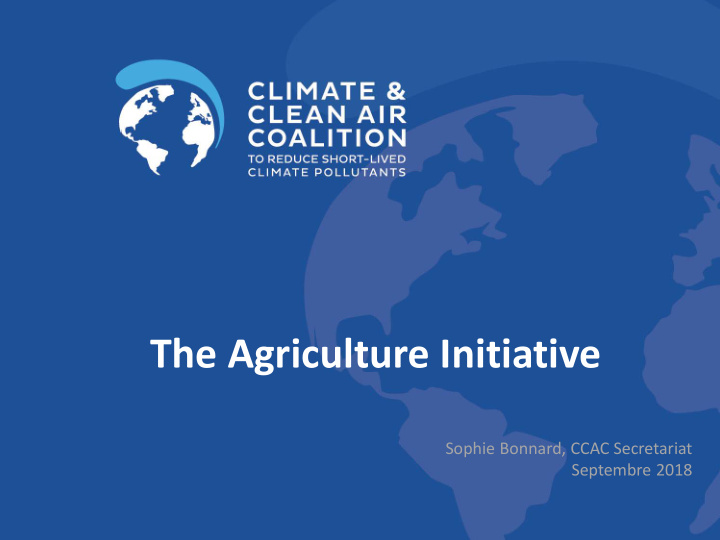



The Agriculture Initiative Sophie Bonnard, CCAC Secretariat Septembre 2018
CCAC overview • UNEP/WMO 2011 assessment report • Control measures for “short - lived climate pollutants” (methane, black carbon, tropospheric ozone, HFCs) o to reduce the rate of near-term climate warming o and bring multiple benefits, incl. air pollution reduction – approximately 2.4 million premature deaths avoided annually, and 52 million tons of avoided crop losses • 7 sectors, 4 cross-cutting initiatives • 120+ partners incl. 60 states • 15 donors (Australia, Canada, Denmark, European Commission, Finland, France, Germany, Italy, Japan, Netherlands, Norway, Sweden, Switzerland, United States, Walloon Region) Objective: rapid widespread adoption and implementation of policies, regulations and practices for large scale uptake of control measures and substantial reductions of SLCPs
Agriculture Initiative • Launched in 2014 • 4 work areas: Open agricultural burning, livestock and manure management, enteric fermentation, paddy rice production • 11 Lead Partners: Bangladesh, Canada, European Commission, Ghana, Japan, New Zeland, Nigeria, USA, FAO, World Bank, ICCI • 11 Implementers: CATIE, DLO, FAO, UN Environment, CIAT, ICCI, ILRI, IRRI, NZAGGRC, PAMETI, SEI • + Many actors incl. GRA, CCAFS • Work with 35 countries • $8.5million allocated • 645 hours of trainings to almost 10,000 participants mainly at the local level; 18 political outreach events; 22 knowledge resources or tools • 40 Instit strenghtened; 3 policies and plans •
Agriculture initiative Key milestones since the 2014 launch: Paddy rice • 3 countries - Vietnam, Bangladesh, Colombia - participate in suitability assessments for alternate wetting and drying rice production • Tools developed for Vietnam to measure, report, and verify greenhouse gas emissions from paddy rice, and support NDC implementation in the rice sector Open burning • Alternatives to open agricultural burning projects started in India and Peru • Strategic Support Groups created in the Andes and Himalaya countries to help governments and local farmers find alternatives to open burning • 6 pilot villages in Punjab, India, have reduced burning by 90% compared to 2014 Enteric fermentation • 13 countries developed baseline and mitigation assessments for enteric fermentation in the dairy and livestock sector using the Global Livestock and Environmental Assessment Model (GLEAM) (with GRA and FAO) • Large scale livestock management programmes in Bangladesh, Ethiopia and Uruguay ($460 million) incorporate mitigation options assessed and be supported on climate mitigation aspects. Livestock and Manure Management • Manure management practice changes identified for Argentina, Bangladesh, Ethiopia, Malawi, Vietnam, and regionally in Central America • National Integrated Livestock Manure Management (ILMM) Policy Developed in Bangladesh
Agriculture initiative Coming up • New funding approved on enteric and manure in Kenya, Indonesia and 1 central America country for improved integration of CH4 mitigation in NDCs, NAMAs and nat policies through better quantification (inventories upgrade), MRV, mitigation action plans and funding mobilization (GRA, FAO, USDA) • New funding approved on paddy rice for engagement of the private sector and support the formulation of NAMAs in the sector and associated mobilization of funds
Growing interest to work on agriculture CCAC Ministers, November 2018: “We resolve to develop policies and measures to reduce emissions from the agriculture sector and help improve the productivity, resilience and livelihoods of farmers. This will involve finding better ways to monitor emissions from livestock and reflecting these results in national climate actions , as well as working with farmers to help eliminate unnecessary open burning , such as through incentives to adopt alternative agricultural practices” High Level Roundtable, 12 September 2018 “How can we make agricultural climate action more attractive?”, San Francisco, US
Draft revised CCAC Agriculture Strategy 2019-2022 1. Raise the ambition of 2030 NDCs to include actions to reduce agriculture SLCPs Invite countries to revise their 2020 NDC Adopt tools to measure and report climate impact/climate benefit for SLCP reduction Work with partners GRA, FAO, WRI, NDC-P, CCAFS, GMI 2. Mobilise funding for large scale climate impact Leverage climate finance (GEF, GCF, Adaptation Fund) Public-private investment/private sector engagement Use the CCAC Solution Centre – e.g. support on emission inventory upgrade for dev of new livestock law Political support - World Bank, regional development banks 3. Build national capacity and capability CCAC “SNAP” support for developing countries Strategy is an opportunity to engage (further) in the initiative and to benefit from expert assistance from solution center
THANK YOU ! Contacts: James Morris, James.Morris@un.org Catalina Etcheverry, Catalina.Etcheverry@un.org Website: http://www.ccacoalition.org/en/initiatives/agriculture
Recommend
More recommend